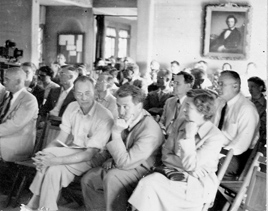1950: Origin and Evolution of Man, Vol. XV
Organizer: Milislav Demerec
Demerec' choice of the "Origin and Evolution of Man" for the topic of the 1950 Symposium is interesting. As he put it: "The ultimate purpose of science, perhaps, is to assist man in understanding himself and his place in the universe", and Demerec may have felt that the mid-point of the 20th century was an appropriate to assess what was known of that place. It was also an interesting choice in the light of the eugenics studies which had flourished at Cold Spring Harbor between 1910 and 1930. The Eugenics Records Office (ERO) established by Charles Davenport with Harry Laughlin as Supervisor, had examined the inheritance of physical traits but rapidly concentrated on behavioral traits. The ERO also carried out anthropological studies, notably those by Morris Steggerda in Jamaica concerned with "race -crossing". By 1940, eugenics had fallen from grace and the ERO was shut down. Nevertheless, many of the issues that had interested Davenport, Laughlin and Steggerda were still pressing in 1950.
Demerec had hoped that the meeting would encourage cooperation between geneticists and anthropologists, but it was clear that the two groups remained far apart in their approaches to the study of mankind. Nowhere was this more evident in the papers and discussions of the concept of race. For the geneticists, Ashley Montagu delivered a scathing critique of the presumed biological basis of race, while for the anthropologists William Sheldon extolled a "constitutional" approach. This the concepts of somatotype ("...the predicted projectory through which a
| 
particular human physique would pass); morphophenotype (what you can see at any particular time) and the morphogenotype (the underlying, unchangeable genetic influence). Sheldon was savaged by the geneticists. Washburn, for example, spoke of the types of classifications Sheldon was proposing as "useless" and Warren wrote that Sheldon's assumptions "...can only alienate the geneticist."
Another controversial presentation was that by Ernst Mayr who expressed his dismay at the way in which the anthropologists so liberally named each hominid fossil with a different name. Even worse, to in Mayr's mind, was that these names were made up with no regard for the international Rules of Zoological Nomenclature. These rules stipulated, for example, that a name has validity only if it includes diagnostic characters. Instead of making up faux nomenclature, Mayr recommended using ordinary names such as the "Sterkfontain find". One feels that one objection the anthropologists had to such a proposal was that using vernacular names stripped away some of the authority conveyed by high-sounding Latin names.
— Jan A. Witkowski |